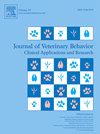Inclined treadmill short-duration exercise for walk regularity of recreation horses
IF 1.3
3区 农林科学
Q4 BEHAVIORAL SCIENCES
Journal of Veterinary Behavior-clinical Applications and Research
Pub Date : 2024-11-01
DOI:10.1016/j.jveb.2024.10.002
引用次数: 0
Abstract
Knowledge on horse symmetry and regularity is essential for every training/rehabilitation programs. Present studies compare biomechanical parameters for different treadmill positions, but not the effect of such exercise. The aim of the presented work was to study recreation horse movement parameters before and immediately after inclined short-duration exercise in walk. The hypothesis was that inclined short-duration exercise gave greater stride regularity and symmetry. Walk biomechanical parameters of 12 Warmblood recreation horses were monitored as temporal data using video analysis [50 frames/s] before and after 5-minute inclined work on a treadmill at 3% incline. Control group (6 horses) consisted from earlier evaluated horses that performed on the other day the same walk exercise without incline. Analysis of variance was conducted for temporal and spatial parameters of walk (237 measurements for incline and 109 for control) using the Mixed SAS procedure. For both data sets the statistical model with the random effect of horse, fixed effects of exercise and successive stride was applied. Control group showed not differences before/after short walk exercise. The influence of inclined exercise was statistically significant for the lateral limbs sequence, regularity and standard deviation of strides regularity (p<0.05). The lateral limbs sequence and regularity increased after inclined exercise (3–5%). The standard deviation of regularity was almost 2-fold lower. Inclined treadmill exercise has a positive effect on walk regularity.
倾斜跑步机短时间运动促进娱乐马匹的行走规律性
有关马匹对称性和规律性的知识对每项训练/康复计划都至关重要。目前的研究对不同跑步机位置的生物力学参数进行了比较,但没有对这种运动的效果进行比较。本研究的目的是研究马匹在短时间倾斜行走运动前后的运动参数。假设是倾斜短时运动能提高步幅的规则性和对称性。通过视频分析[50 帧/秒],对 12 匹温血马在 3% 倾角的跑步机上进行 5 分钟倾斜运动前后的行走生物力学参数进行了监测。对照组(6 匹马)由之前进行过评估的马匹组成,这些马匹在另一天进行了同样的无坡度步行运动。使用混合 SAS 程序对行走的时间和空间参数(237 次倾斜测量和 109 次对照测量)进行了方差分析。两组数据均采用了马匹随机效应、运动和连续步幅固定效应的统计模型。对照组在短距离步行运动前后没有差异。倾斜运动对侧肢顺序、步幅整齐度和步幅整齐度标准偏差的影响具有统计学意义(p<0.05)。倾斜运动后,侧肢序列和步幅整齐度增加了(3-5%)。步频的标准偏差几乎降低了 2 倍。倾斜跑步机运动对步行规则性有积极影响。
本文章由计算机程序翻译,如有差异,请以英文原文为准。
求助全文
约1分钟内获得全文
求助全文
来源期刊
CiteScore
3.50
自引率
16.70%
发文量
107
审稿时长
325 days
期刊介绍:
Journal of Veterinary Behavior: Clinical Applications and Research is an international journal that focuses on all aspects of veterinary behavioral medicine, with a particular emphasis on clinical applications and research. Articles cover such topics as basic research involving normal signaling or social behaviors, welfare and/or housing issues, molecular or quantitative genetics, and applied behavioral issues (eg, working dogs) that may have implications for clinical interest or assessment.
JVEB is the official journal of the Australian Veterinary Behaviour Interest Group, the British Veterinary Behaviour Association, Gesellschaft fr Tierverhaltensmedizin und Therapie, the International Working Dog Breeding Association, the Pet Professional Guild, the Association Veterinaire Suisse pour la Medecine Comportementale, and The American Veterinary Society of Animal Behavior.

 求助内容:
求助内容: 应助结果提醒方式:
应助结果提醒方式:


